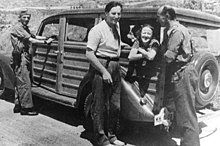Gerda Grepp
Gerda Grepp | |
|---|---|
 Gerda Grepp, with Nordahl Grieg and Ludwig Renn | |
| Born | 26 May 1907 |
| Died | 29 August 1940 (aged 33) Norway |
| Resting place | Vestre gravlund, Oslo, Norway |
| Occupation | Journalist War correspondent |
| Nationality | Norwegian |
| Relatives | Kyrre Grepp (father) Rachel Grepp (mother) |
Gerda Johanne Helland Grepp[1][2] (26 May 1907 – 29 August 1940) was a Norwegian translator, journalist, and socialist.[3] She was the daughter of former chairman of the Norwegian Labour Party Kyrre Grepp and journalist Rachel Grepp.[4][5]
She was married to Italian-Swiss potter Mario Mascarin (1901–66). They had a son Olav Kyrre (Ping) Grepp and a daughter, Solveig Marie Alexandra "Sacha" Grepp. The daughter was named after family friend Alexandra Kollontai.[6]
Spanish Civil War
[edit]Grepp covered the Spanish Civil War as a reporter for the Labour Party newspaper Arbeiderbladet from 1936. She arrived in Barcelona in October 1936, as the first female reporter from Scandinavia.[4] She travelled to Madrid, where she experienced bombing attacks on the city. With Ludwig Renn she drove to the Toledo front.[4] During her travels, she was also accompanied by her friend André Malraux.[7] While in Spain, Grepp served as an interpreter for other Norwegians.[7]
Both Grepp and the other Norwegian correspondents in Spain, like Nordahl Grieg and Nini Gleditsch, sympathized with the Republican cause in the war.[7] Gleditsch and Grepp helped organize a large-scale aid effort for Spain, based around the Norwegian labour movement.[8]
According to professor Rune Ottosen, Grepp and Birgit Nissen were marked with "sharp pens against the growing fascism".[9]
In January and February 1937 she visited Málaga, together with Hungarian journalist and reporter for the British daily newspaper News Chronicle, Arthur Koestler.[5][10] She and Koestler took shelter with the eccentric 72-year-old Sir Peter Chalmers Mitchell, who had stayed on in Málaga "to protect his house and servants" while his compatriots fled to Gibraltar.[11] During the battle of Málaga she barely escaped the attacking Nationalist forces.[12] Grepp left Málaga on 6 February, while Koestler was still in the city. On 7 February Italian troops occupied the city. Koestler was arrested, sentenced to death as a spy, and placed in a death cell in Sevilla. However, after considerable international pressure, he was released from custody. This episode is recorded in detail in Sir Peter's memoir, recently republished by The Clapton Press.[10] From May 1937 Grepp spent several weeks in the Basque Country. She visited the Republican Basque Army defensive line called the Iron Belt, and experienced the Battle of Bilbao.[13] Grepp frequently found herself in dangerous situations while in Spain.[12] During her time in Spain Grepp was suffering from tuberculosis. Eventually she was compelled by her ill health to leave the war zone and return to Norway.[7]
Death and legacy
[edit]Gerda Grepp died of tuberculosis in German-occupied Norway on 29 August 1940, 33 years old.[7][14] She was buried in Vestre gravlund in Oslo.[1] Grepp's work has since been largely forgotten, her fellow journalist Lise Lindbæk instead being commonly seen as Norway's first female war correspondent.[12]
A biography of Grepp, written by Elisabeth Vislie, was published in 2016.[15]
References
[edit]- ^ a b Kirkevergens database. Oslo Municipality, funeral agency. 2006. Accessed through the grave-site registry of the Genealogy Society of Norway (DIS), select "Id" from the drop-down menu labelled "Find" and enter "675648".
- ^ Vislie 2016: p. 25
- ^ Preston, Paul (2008). We Saw Spain Die: Foreign Correspondents in the Spanish Civil War. Constable. pp. 259–276.
- ^ a b c Moen, Jo Stein; Sæther, Rolf (2009). "Norges første kvinnelige krigsreporter". Tusen dager. Norge og den spanske borgerkrigen 1936-1939 (in Norwegian). Oslo: Gyldendal. pp. 63–70.
- ^ a b Evensmo, Sigurd (1976). Inn i din tid (in Norwegian). Oslo: Gyldendal. pp. 87–88. ISBN 82-574-0250-8.
- ^ "Sacha i Andesmauet". Stavanger Aftenblad. 4 December 2003. Retrieved 2 December 2019.
- ^ a b c d e Stanghelle, John (1993). Nini Haslund Gleditsch - opprør - ein biografi (in Norwegian). Oslo: Samlaget. pp. 108–10. ISBN 82-521-3931-0.
- ^ Førland, Tor Egil; Tønnesson, Stein; Grimnes, Ole Kristian; Koefoed, Holger (1997). Verden etter 1850 (in Norwegian). Oslo. p. 167.
{{cite book}}: CS1 maint: location missing publisher (link) - ^ Ottosen, Rune (1996). Fra fjærpenn til Internett: Journalister i organisasjon og samfunn (in Norwegian). Oslo: Aschehoug. p. 107. ISBN 82-03-26128-0.
- ^ a b Moen, Jo Stein; Sæther, Rolf (2009). "Malaga faller". Tusen dager (in Norwegian). Oslo: Gyldendal. pp. 106–113.
- ^ "Sir Peter Chalmers Mitchell, My House in Málaga, (1938), London, The Clapton Press". 29 May 2019.
- ^ a b c Tretvoll, Halvor F. (12 October 2009). "Hun var den dristigste av alle". Dagsavisen (in Norwegian). Archived from the original on 15 October 2009. Retrieved 23 January 2010.
- ^ Moen, Jo Stein; Sæther, Rolf (2009). "I skyggen av Guernica". Tusen dager (in Norwegian). Oslo: Gyldendal. pp. 115–120.
- ^ Moen, Jo Stein; Sæther, Rolf (2009). "Siste kapittel". Tusen dager (in Norwegian). Oslo: Gyldendal. pp. 63–70.
- ^ Vislie, Elisabeth (2016). Ved fronten. Gerda Grepp og den spanske borgerkrigen (in Norwegian). Oslo: Pax Forlag. ISBN 978-82-530-3866-7.


 French
French Deutsch
Deutsch